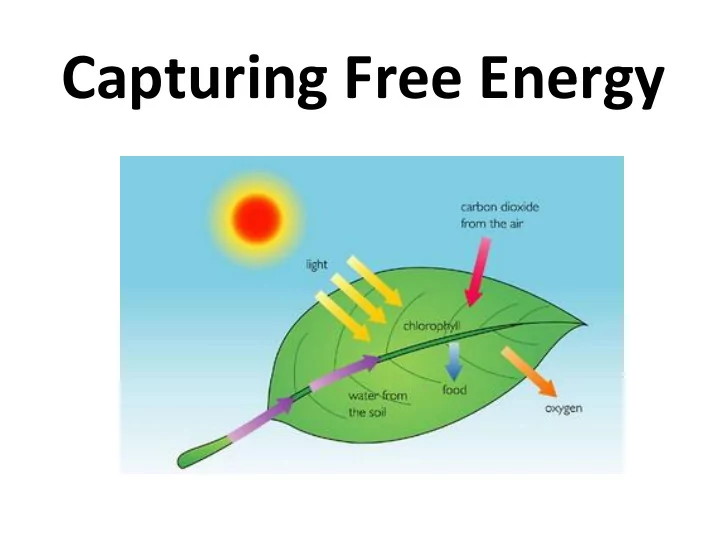

Capturing Free Energy
Capture and Store Free Energy • Autotrophs : capture free energy from the physical environment – Photosynthetic – sunlight – Chemosynthetic – inorganic molecules • Heterotrophs : capture free energy in carbon compounds
Chemosynthesis
Summary of Photosynthesis
Electromagnetic Spectrum
Chlorophyll a and b Absorption
Chloroplast
Summary
Photosynthesis Reaction (another REDOX reaction)
Light Absorption by the Chlorophyll Pigments • Photosystems are embedded within the thylakoid membranes of chloroplasts
Light Absorption by the Chlorophyll Molecules • Clusters of chlorophyll pigments called photosystems absorb light energy (photons) • Light energy “excites” electrons of the chlorophyll pigments • Shorter wavelengths of light have more energy and are therefore more effective at “exciting” electrons
Light-Dependent Reactions Chemiosmosis and Photophosphorylation
Light-Dependent Reactions (occurs within thylakoids) During the light reactions: • Light energy splits water molecules into hydrogen ions (H + ) and oxygen gas – this is called photolysis • Two high energy compounds, ATP and NADPH , are also produced (energy building reactions) • ATP and NADPH transfer free energy to the light- independent reactions (Calvin Cycle)
Calvin-Benson Cycle (Light-Independent)
Calvin-Benson Cycle (with the stroma) During the Calvin-Benson Cycle: • “Carbon fixation” occurs – “fixing” inorganic carbon (from CO 2 ) into organic carbon( G3P molecules) • CO 2 combines with a five-carbon sugar called RuBP (forms an intermediate 6-carbon compound) • Energy stored in ATP and NADPH is used to convert the temporary 6- C intermediate compound into G3P molecules
G3P molecules (End Product) • Glyceraldehyde 3-phosphate • An intermediate in photosynthesis • G3P molecules : – Immediate food nutrient in plants – Combined to form monosaccharides (glucose) – Transported to other cells – Packaged for storage in polysaccharides (starch and cellulose)
Where does plant mass come from?
Recommend
More recommend